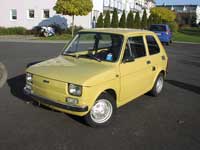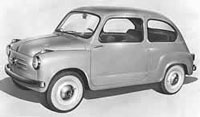Fiat 126 vs Porsche
I'm not sure if it's a 500bhp FIAT 126p from United Kingdom or Fiat 126p from Poland but it faster than Porsche
The blog about small and funny car Fiat-126.
 Despite beliefs to the contrary the 126 was actually designed to fill a gap between the Nuova 500 and the 127. The 500 was looking increasingly basic and was still only a 2 seater that could house 2 children in the back at a pinch. Performance was also starting to become unacceptable. Although the 500 was discontinued in some countries at the same time the 126 was introduced, in Italy there was an overlap of 3 years between the 2 cars.
Despite beliefs to the contrary the 126 was actually designed to fill a gap between the Nuova 500 and the 127. The 500 was looking increasingly basic and was still only a 2 seater that could house 2 children in the back at a pinch. Performance was also starting to become unacceptable. Although the 500 was discontinued in some countries at the same time the 126 was introduced, in Italy there was an overlap of 3 years between the 2 cars. The 126 was unveiled at the Turin Motor Show in October 1972. A fleet of 126s was made available to motoring journalists so that they could experience the car in a bustling city, the ideal place for such a car. It was enthusiastically received apart from minor reservations on the styling. The similarity to the styling of the 127 was remarked upon by many, but it was nowhere near as cute as the Nuova 500, and this would be the cars downfall in later years when the 500 became a cult classic while 126s lay rotting in scrap yards. In Britain the car was launched in RHD form in July 1973. Brochures of the time featured the Metropolitan Police who had been given a car to drive non-stop for 7 days and nights around the Isle of Man TT Course. The car averaged 41mph and returned 51mpg, requiring only the adjustment of the points and timing on the final morning of the stunt.
The 126 was unveiled at the Turin Motor Show in October 1972. A fleet of 126s was made available to motoring journalists so that they could experience the car in a bustling city, the ideal place for such a car. It was enthusiastically received apart from minor reservations on the styling. The similarity to the styling of the 127 was remarked upon by many, but it was nowhere near as cute as the Nuova 500, and this would be the cars downfall in later years when the 500 became a cult classic while 126s lay rotting in scrap yards. In Britain the car was launched in RHD form in July 1973. Brochures of the time featured the Metropolitan Police who had been given a car to drive non-stop for 7 days and nights around the Isle of Man TT Course. The car averaged 41mph and returned 51mpg, requiring only the adjustment of the points and timing on the final morning of the stunt. In 1933 Fiat announced an internal competition, open to all their departments, to design a small car for the masses. The winning design was penned by Dante Giacosa from the aviation division. The car, officially the 500, became known as the Topolino. It had a 569cc four cylinder side-valve engine hung out ahead of the front axle. This was coupled to a 4 speed gearbox with synchromesh on 3rd and top that carried drive to the rear wheels. Front suspension was independent by transverse leaf and a live rear axle was employed. The car had 12V electrics and hydraulic brakes. For a small car this was all quite advanced. Originally it had been planned to make the car front wheel drive, but the difficulty and expense of constant velocity joints put a stop to that. The car was designed as a pure 2 seater which allowed a reasonable amount of luggage room. This really was a very small car with a wheelbase of only 6ft 6in. Weighing in at just 535kg the 13bhp engine gave sprightly performance for the time and had a top speed of 53mph. The car endured for the next 17 years. During this time it was very successful in all forms of competition including the Monte Carlo Rally and the Mille Miglia road race. In 1948 the side-valve engine was replaced by an overhead valve engine producing 16.5bhp and the car became the 500B. This raised top speed to 60mph. In 1949 the Topolino was restyled and became the 500C. Total production of the Topolino amounted to about 520,000 units.
In 1933 Fiat announced an internal competition, open to all their departments, to design a small car for the masses. The winning design was penned by Dante Giacosa from the aviation division. The car, officially the 500, became known as the Topolino. It had a 569cc four cylinder side-valve engine hung out ahead of the front axle. This was coupled to a 4 speed gearbox with synchromesh on 3rd and top that carried drive to the rear wheels. Front suspension was independent by transverse leaf and a live rear axle was employed. The car had 12V electrics and hydraulic brakes. For a small car this was all quite advanced. Originally it had been planned to make the car front wheel drive, but the difficulty and expense of constant velocity joints put a stop to that. The car was designed as a pure 2 seater which allowed a reasonable amount of luggage room. This really was a very small car with a wheelbase of only 6ft 6in. Weighing in at just 535kg the 13bhp engine gave sprightly performance for the time and had a top speed of 53mph. The car endured for the next 17 years. During this time it was very successful in all forms of competition including the Monte Carlo Rally and the Mille Miglia road race. In 1948 the side-valve engine was replaced by an overhead valve engine producing 16.5bhp and the car became the 500B. This raised top speed to 60mph. In 1949 the Topolino was restyled and became the 500C. Total production of the Topolino amounted to about 520,000 units.
 The Nuova 500 remained in production for the next 18 years. During this time the engine grew to 499cc producing 17.5bhp, and then received another power hike to 22bhp in 1965. In 1972 the Fiat 126 was introduced. For 3 years there was a Nuova 500R made that used the floorpan and most running gear from the 126. This car ceased production in 1975. As well as the saloon car there was an estate car, the Giardiniera, which had the engine positioned horizontally so that a flat floor could be installed. Over 4 million Nuova 500s were produced during its long life. The car has become a cult classic all around the world.
The Nuova 500 remained in production for the next 18 years. During this time the engine grew to 499cc producing 17.5bhp, and then received another power hike to 22bhp in 1965. In 1972 the Fiat 126 was introduced. For 3 years there was a Nuova 500R made that used the floorpan and most running gear from the 126. This car ceased production in 1975. As well as the saloon car there was an estate car, the Giardiniera, which had the engine positioned horizontally so that a flat floor could be installed. Over 4 million Nuova 500s were produced during its long life. The car has become a cult classic all around the world.